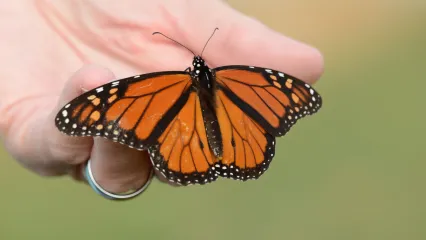
Description
Biologists are able to identify this creatively named mollusk primarily by the knobbed and ridged shell. With a good dash of imagination, this thick brown shell is said to resemble the face of a monkey when viewed from the edge. Other characteristics include a square shell marked with small, dark green triangles.
Size
Up to 5 inches.
Habitat
Northeastern Oklahoma is on the southwestern edge of the monkeyface’s range; the bulk of the range is in the United States’ Midwest Region. Monkeyface mussels, or their remnants, have been found in the Verdigris, Neosho and Caney rivers of Oklahoma’s Green Country. These mussels typically prefer clear, swift moving water and are most often found in riffles and graveled areas of streams and rivers.
Life Cycle
Monkeyface mussels are filter feeders; as they draw water through their valves, food particles (algae, bacteria, protozoans and other organic matter) are captured on the gills and carried to the mouth by hair-like structures found on the gills. Once the eggs are fertilized by upstream males, they are brooded on the female mussel’s gills. After three months, the eggs have developed into small larvae, or glochidia. These larvae, less than one-tenth the size of a mustard seed, then clasp onto the gills or fins of a nearby fish. But any nearby fish won’t do. Different species of mussels have different host fish. For monkeyface mussel larvae to develop into juvenile mussels, they must clasp on to the gills or fins of bluegill or other sunfish, or sauger. After the larvae have developed into mussels, they detach from the fish, slowly sink to the bottom of the river, and begin their life as mostly-stationary adults.


